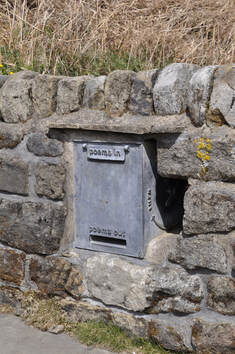|
By Abbi Flint (WetFutures UK team)  Photo of poetry postbox on Ilkley Moor by B. Jennings Photo of poetry postbox on Ilkley Moor by B. Jennings In November last year, Ben Jennings and I published an open access article in the journal Time and Mind on how the archaeology and folklore of peatlands might play a role in how people engage with and think about these landscapes. The article is open access, so anyone can read it, but we realise that not everyone wants to read academic articles. As I write poetry outside of my day job, I was keen to explore the potential of using poetry as a creative way of sharing the Ideas we had written about. The poem below aims to do that, creatively responding to key ideas from the article, but exploring these in a poetic way. You can watch a video that Ben Jennings has put together, with me reading the poem over images of Ilkley Moor, here: https://youtu.be/o1VlbEuVJOI, and the full text of the poem is below. Saturated with Stories Peatlands blur water and earth, a shape- shifting land where past and present collapse where nature and culture entangle. If we listen, what story will they tell? This story begins before words with trees cleared by people, by climate, to form peat. This story begins with absence from maps wastelands to be tamed and drained into use damage that outlasts generations. This story begins with Holmes on a mire haunted and dangerous. Wild tales of moors as ancient and alien. It’s a story of other-than-human, of black moor-dogs of bottomless depths, of Will-o’-the-Wisps faeries that dwell in watery places. Where bodies are not lost but intentionally interred in liminal spaces. This story begins with people. Of living and working, burying and remembering, healing, forgetting, walking to escape. This story is unspoken, needs science to translate what was quietly written in archives of pollen and fragments. This is a story of wilderness managed for water, for carbon, for nature as a resource for our future. This is a story of balance. On Ilkley Moor, a peaty palimpsest from Neolithic to today, written in traces of settlements and standing stones rocks carved and circled for reasons unknown. Where a giant’s wife spilled Skirtfuls of Stones giving way to big cats and UFOs. ‘Metropolis of hydros’, the ‘mountain spa’ where a song warns of going out baht’at and where Darwin came for the ‘water cure’. Today, Stanza Stones are etched with poetry and ancient paths trace crash-sites through sheep-folds to quarries, where land was made to work where commoners hold rights to graze and walk. These stories re-enchant peatlands. Stories that are still being written, an ‘unbroken dialogue’ with more than one voice. Widening the lens changes our view of peatlands as plural, old and new. What futures tales will tell of crashed bikes of curlew, of poetry, of rewetted bogs? Shared stories make space for shared ownership where we all play our part in the telling and co-create new forms of heritage. Peatlands are saturated with stories. In writing this piece, I’ve been inspired by work on poetic inquiry as a research method (e.g. Faulkner, 2020) and as a way of engaging with and communicating research findings (for more examples of this check out the science poetry journal Consilience and the recent University of Bradford Continuing Bonds creative dissemination project). Of course, this is also part of a rich tradition of writing about archaeology and landscape through poetry (see also our WetFutures Ireland colleagues Ben and Rosie's piece on Seamus Heaney’s ‘bog poetry’).
What do you think? Is poetry a useful way to share ideas and research about peatland heritage? We’d love to hear your thoughts either in the comment box below or on twitter (@WetFutures)
0 Comments
Leave a Reply. |
Archives
April 2021
Rosie EveretTRosie is the latest member of the WetFutures team and is here to keep you all updated on the latest WetFutures news! |

 RSS Feed
RSS Feed
